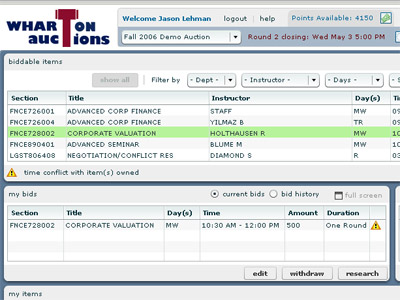Rich Internet Application Case Study: Picking Classes at the Wharton School

How are Rich Internet Applications changing people’s lives? Well at the
Graduate students at Wharton choose their elective classes using an auction system. Each student is given 5000 points at the beginning of their career at Wharton which they then use to begin bidding on electives. The most popular classes and professors therefore command the most points. Once a student has "won" a place in a class, they can then auction that place in the class off to other students as a way to get more points for other classes. In essence, getting the classes you want to take at Wharton requires business acumen right from the start.

Before this year, the students used a simple web application written in Adobe's ColdFusion. This year, the application was rewritten using Adobe's Flex 1.5 for the front end and keeping ColdFusion as the middle tier. Using ColdFusion and Flex 1.5 proved to be a very good environment and most of the ColdFusion code stayed the same which allowed Jason to focus on building the interface with Flex. In true Web 2.0 fashion, nearly all of the data for the application is generated by the students themselves. They provide information about how good certain professors and courses are and the application exposes that data in a series of reports that aid the students in their course selection.
During the development of the application, the goal was to make the interface as user friendly and powerful as possible. Students make heavy use of the reports during the auction process. They need to track their points, the trends for class auctions and which classes are still available in a way that allows them to make good decisions using the information. Reports on the new interface are customizable so that the students can see the data exactly how they want it. This makes it more valuable to them and gives them a better chance of getting the classes they want. All of the screens they need are available from the menu and it is easy to switch between reports and the bid screen. They can quickly switch over to their current schedule after making a bid for a course they’ve done research on. By using transitions, the users have a sense of where things are and how to go back to them quickly. It helps maintain their frame of reference as interact with parts of the application. Finally, because this application uses Flash it can run regardless of the browser and is available to students using PCs or Macs. Every student sees the exact same application despite differences in their environment. This is a big deal when, as a student, you're relying on this application to get the classes you want.
The response to the application has been overwhelmingly positive and has given future business leaders an eye into the world of Rich Internet Applications. According to Jason there have been 838 distinct users who have logged into the application and they've placed a total of 37,212 transactions (this includes bids, asks, edits, and withdrawals). It's clear that the students not only find the application valuable, but also fun to use. The course auction is definitely a Rich Internet Application at it's finest. It focuses heavily on the user experience while delivering a powerful tool that makes workflow more efficient. That's something that hits home with business students and provides a great example of how RIAs can make applications better.
I want to give a big thanks to Jason for putting the demo together and taking the time to talk with me about the course auction. There is a great demo of the auction at http://auctions.wharton.upenn.edu/demo/index.html